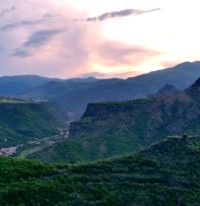Armenia
Akhtala
Our first stop after crossing the border was the fortified Akhtala Byzantine Monastery, known for its 13th Century artistic frescoes.
It's well positioned for defence and the site has been in use since the Bronze Age (13th century BCE), the derivation of the name 'Akhtala' being 'copper mine'. The main gate and part of the wall remains but outlying buildings and other defences are in ruins.
Akhtala Monastery
There are more images in the Armenia Album See more...
It's said that when Timur (Tamerlane) arrived here he was admiring the church alone when he heard the sound of a baby. He decided that the cry had come from the painting of the Virgin and Child on the dome above the alter. So he ordered their beheading. The story says that the cry had come from a real baby hidden from the invaders with its mother and others in the space behind the alter.
We had fun speculating how his troops went about fulfilling Timur's order and decided it they must have used a large projectile, perhaps fired from an early cannon, a century before the Ottoman and Arabic 'Gunpowder Empires' - where cannon were first used in battle.
Timur was technologically adept and highly intelligent, outsmarting the best of his opponents. He'd moved water courses to hamper opposing armies and used fire-camels against war elephants so why not? Read more...
Fortunately, despite a propensity for levelling entire cities and mercilessly slaughtering their inhabitants, Timur was quite intellectual and eclectic in his interests, frequently sparing structures he liked. By his lights a civilised man. So the church got off well - it's still standing.
Focussed damage to behead an image of the Virgin and Child - attributed Tamerlane
It looks as if quite accurately shot from below - was it done with a projectile? Gunpowder?
There are more images in the Armenia Album See more...
That Armenia is not as well off as Georgia was immediately apparent from the state of the regional roads the peoples' houses and the ruined industrial infrastructure. Dozens of large industrial sites lie abandoned rusting and crumbling away. Our guide told us that when the Soviet Union collapsed Armenia was particularly hard hit and as we learned in Azerbaijan, came under almost immediate attack - or was it the other way around? Industry collapsed workers lost their jobs, the Russians who had provided local government and technical knowhow departed and social infrastructure and social security collapsed. People in the cities starved. It took some time for competent government to be re-established.
There seemed to be endless abandoned industrial buildings some of them old copper smelters
In places the regional roads are so bad that we were reduced to walking pace - dodging potholes
In particular the electricity failed when the Russian maintained Nuclear Power Plant was shut down. This was built without secondary containment around the reactors, like Chernobyl. After Chernobyl even the Russians were having second thoughts. And this one is in an earthquake zone. Yet the impact of its closure was so dire that it was reopened. One reactor is still running. Checking this out on-line I learned that:
The Armenian Nuclear Power Plant, also known as the Metsamor Nuclear Power Plant, is located 36 kilometres west of Yerevan. Two model V-230 reactors, each of 407.5 MWe gross (376 MWe net), were built at Metsamor on solid basalt and supplied power from 1976 and 1980 respectively. Design operating lifetime was 30 years... One of these is still running. The operating licence has been extended to 2021. In September 2013 Russia announced an agreement to undertake works to extend the operating lifetime of the plant by ten years, and in May 2014 Russia agreed to provide $300 million for upgrading the plant to enable lifetime extension to 2026. It has survived one major earthquake without damage. The combination of design and location of Metsamor has been claimed to make it among the most dangerous nuclear plants in the world.
(sources: World Nuclear Association; Wikipedia)
The plan, that, as an advocate of nuclear power in place of fossil fuel, I applaud, is to replace it with a safe, modern plant. Given the decaying state of Soviet era infrastructure in the country at large we can only hope that they are speedy about it.

